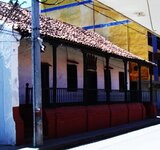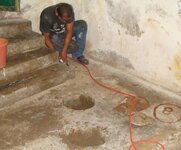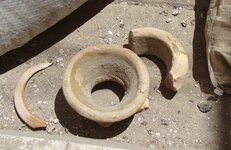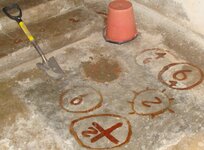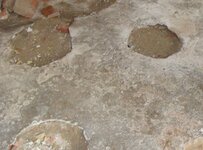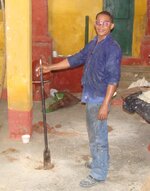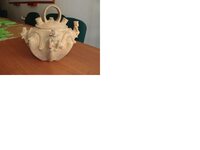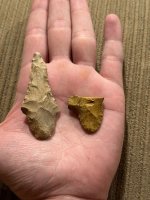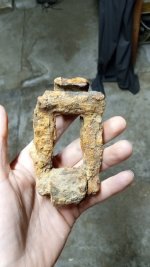OK, wish me luck... I've finally begun to search an old house that I've been trying to get into for about a year... "Don Hernan" (pseudonym for the old man who's the owner) finally felt comfortable enough to let me in to search the property. It's thought to be one of the oldest buildings in this colonial city, built around 1550 as a viceroy's palace, yet the roof and plastering are newer, dating to around 1680. There has been no apparent modernization other than to add indoor plumbing (one bathroom) about thirty years ago. Unfortunately, the entire interior floor area (both all rooms indoors and outside around the central courtyard) are all covered with modern concrete dating to between around 1890 to 1930.
I was unable to attach photos, but if I can figure out how to downsize them I will update later.
Don Hernan says he's agreeable to breaking up the floor if I think there's treasure beneath, and I plan to dig all targets. He's been trying to sell the house for awhile and move into an apartment and I'm guessing that he wants to satisfy his curiosity about whether his lifelong home contains any hidden treasure. There is anecdotal evidence that a huaca was discovered around forty years ago by workmen repairing a back wall, and the proceeds from that reported treasure were said to have been used by the family for the construction of a modern building on a nearby site.
I plan to spend as much time as it takes, or as long as he'll let me stay; I've budgeted a couple hours a day for a whole month. A part of the house was searched with a metal detector about fifteen years ago, and several relics were discovered, including a couple pieces of silverware, yet no gold. Even though I would have preferred to begin by searching around the old courtyard, because "ghosts" have told Don Hernan that the treasure is to be found below the floor of a certain side gallery in the building, so to humor him that's where I've begun the search; still, I'm trying to keep an open mind and I try to have in my mind a picture of how this place may have looked three or four hundred years ago. To begin, I've searched the entire floor of this gallery twice with a Garrett 2500 (I also have a SeaHunter, which may be better for the salt here) and have marked the target locations on the concrete floor using paint.
Tomorrow I'll go back over everything with either/both the 2500 and the SeaHunter. I also have the two-box setup for the 2500 so I'll probably try that also. Then I'll have my workman start breaking up the concrete floor over the marked target areas, using a compressor and pneumatic hammer and hoping to avoid damaging the house through excessive vibration. Of course, we'll also need to fill in the holes and top with new concrete, plus dispose of all the dirt which won't fit back into its hole... After finishing this first area (one of two side galleries) I'll move to the courtyard area. I'm hoping to learn as I go, and by the time I finish the house completely the first time in a few weeks, including walls and ceilings, if I still have access I'll come back again. This is all assuming that Don Hernan doesn't become prematurely discouraged if we only discover iron at first.
Any thoughts about how to best focus on finding the goodies (if they exist), yet without breaking up and digging under the entire concrete floor? Thanks!
EF
I was unable to attach photos, but if I can figure out how to downsize them I will update later.
Don Hernan says he's agreeable to breaking up the floor if I think there's treasure beneath, and I plan to dig all targets. He's been trying to sell the house for awhile and move into an apartment and I'm guessing that he wants to satisfy his curiosity about whether his lifelong home contains any hidden treasure. There is anecdotal evidence that a huaca was discovered around forty years ago by workmen repairing a back wall, and the proceeds from that reported treasure were said to have been used by the family for the construction of a modern building on a nearby site.
I plan to spend as much time as it takes, or as long as he'll let me stay; I've budgeted a couple hours a day for a whole month. A part of the house was searched with a metal detector about fifteen years ago, and several relics were discovered, including a couple pieces of silverware, yet no gold. Even though I would have preferred to begin by searching around the old courtyard, because "ghosts" have told Don Hernan that the treasure is to be found below the floor of a certain side gallery in the building, so to humor him that's where I've begun the search; still, I'm trying to keep an open mind and I try to have in my mind a picture of how this place may have looked three or four hundred years ago. To begin, I've searched the entire floor of this gallery twice with a Garrett 2500 (I also have a SeaHunter, which may be better for the salt here) and have marked the target locations on the concrete floor using paint.
Tomorrow I'll go back over everything with either/both the 2500 and the SeaHunter. I also have the two-box setup for the 2500 so I'll probably try that also. Then I'll have my workman start breaking up the concrete floor over the marked target areas, using a compressor and pneumatic hammer and hoping to avoid damaging the house through excessive vibration. Of course, we'll also need to fill in the holes and top with new concrete, plus dispose of all the dirt which won't fit back into its hole... After finishing this first area (one of two side galleries) I'll move to the courtyard area. I'm hoping to learn as I go, and by the time I finish the house completely the first time in a few weeks, including walls and ceilings, if I still have access I'll come back again. This is all assuming that Don Hernan doesn't become prematurely discouraged if we only discover iron at first.
Any thoughts about how to best focus on finding the goodies (if they exist), yet without breaking up and digging under the entire concrete floor? Thanks!
EF




